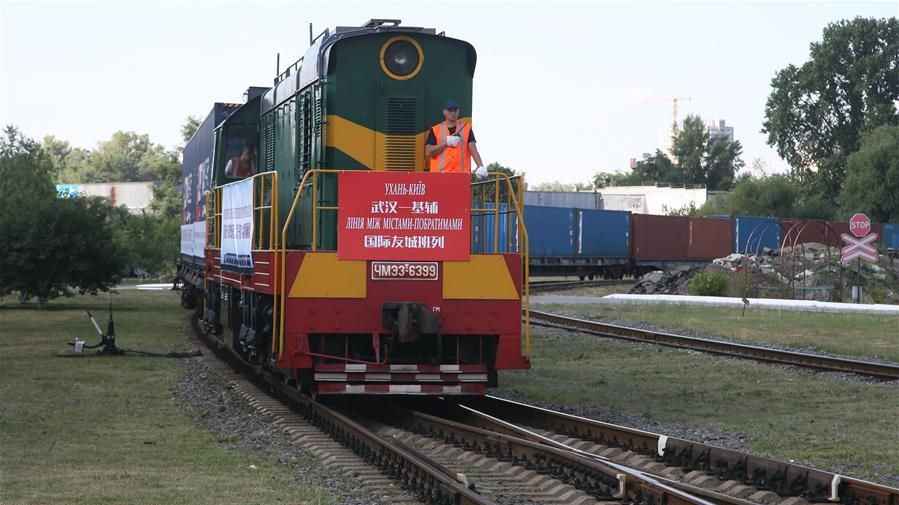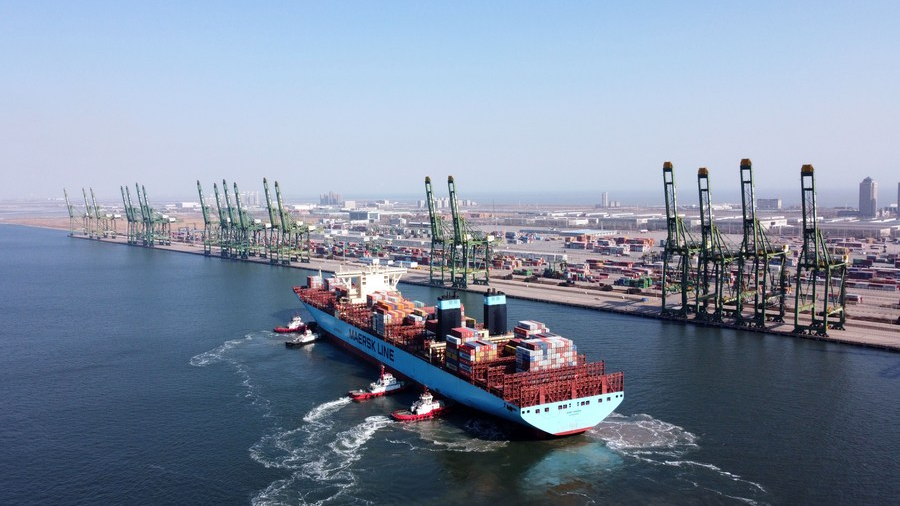
A container train from China's Wuhan enters a railway station in Kiev, Ukraine, July 6, 2020. [Photo/Xinhua]
By Wang Huiyao
The current conflict between Russia and Ukraine has lasted for more than a month. According to the United Nations, as of March 30, the conflict has caused over 4 million Ukrainian refugees to flee their homeland, and as of April 1, there are at least 1,276 Ukrainian civilians were known to have died and 1,981 injured. Europe faces its largest influx of refugees since World War II. Not only have global energy resources and trade activities been impacted, European security and the international system formed after World War II have also been challenged. At one point, Russia even indicated it could use nuclear weapons if its survival was threatened.
The ongoing COVID-19 pandemic together with the Russia-Ukraine conflict has brought the human race face to face with a new Bretton Woods moment. We need to think about how humanity has maintained peace for the past 77 years and why it has come to the edge of world war again.
The Bretton Woods Conference, held in July 1944, established international institutions like the International Monetary Fund and the International Bank for Reconstruction and Development (predecessor of the World Bank) to manage the post-war international monetary system, which promoted the construction of a new post-war international monetary system. For decades, the world economic landscape developed based on the Bretton Woods system, including the General Agreement on Tariffs and Trade and now the World Trade Organization, has contributed to a virtuous cycle of openness, trade, prosperity and stability. Global trade has become the greatest stabilizer of world peace since World War II.
At the end of World War II trade accounted for merely 5 percent of global GDP. Global foreign direct investment increased eight-fold from 1950 to 1970. By the end of the previous century, total global import and export trade accounted for 50 percent of global GDP. In 1950, global import and export trade totaled $61 billion, total global trade reached a record $28.5 trillion in 2021, an increase of as much as 466 times.
In recent years, however, the role of international military alliances increased as the international power landscape evolved. For example, NATO has expanded eastward five times. The U.S. probably wants to create a smaller version of NATO in Asia through multilateral military alliances with Japan, South Korea, Australia and India. This is in addition to the security pact "AUKUS" that has already been established by the U.S., the UK and Australia. The outbreak of the Russia-Ukraine conflict shows the increased danger of confrontation with military alliances, which could cause a new arms race due to isolation and suspicion, leading to accidental conflicts or regional conflicts that threaten security and stability. The world needs to continue to foster the prosperity and development that had been achieved through institutions like the World Trade Organization, the International Monetary Fund, World Bank, AIIB and others.

A container vessel sails into Tianjin Port in north China's Tianjin Municipality, February 22, 2021. [Photo/Xinhua]
Economic globalization remains a major trend in world development. In the future, avoiding new regional and world wars means relying on economic alliances rather than military alliances. Economic cooperation and regional alliances, as a manifestation of economic globalization, are more aligned with the interests and needs of global development and more sustainable in the long run. These alliances create larger interconnected markets that complement regional advantages, provide mutual benefit, enhance regional prosperity and development, and encourage friendly exchanges and cooperation.
In recent years, China embraced an even more open attitude to the world, expanding the circle of its trade and achieving rapid development. Part of this has been the China-led Belt and Road Initiative (BRI), the Asian Investment Bank and the China-Africa Cooperation Forum. China also joined the Regional Comprehensive Economic Partnership Agreement, signed the China-Europe Investment Agreement, and applied to join the Comprehensive and Progressive Trans-Pacific Partnership Agreement as well as the Digital Economy Partnership Agreement. China is currently the largest trading partner for over 130 countries. By deepening international economic and trade cooperation and aligning with international rules, China has released more potential and cooperated with other countries to create mutual benefit, and link its own prospects with those of other countries around the world, which has succeeded in creating goodwill and trust.
There is a lot of room for cooperation between China and the United States. Given the major role the U.S. and Europe have taken in the Russia-Ukraine conflict, China's potential role as a neutral mediator stands out. Chinese President Xi Jinping has expressed his willingness to provide further humanitarian assistance, and called on all parties to work together to support dialogue and negotiations between Russia and Ukraine. In this regard, China could seek to form a multiparty talk mechanism including the five permanent members of UN Security Council, Ukraine and the EU within the UN framework, and facilitate a ceasefire between the two sides. This would ultimately bring stability back to Europe and reduce the potential for a return of instability after the ceasefire
Other global areas in which there is room for cooperation include infrastructure, climate and carbon neutrality. China and the U.S. should work together with countries from around the world to strengthen the docking of development projects and enhance the linkage of economic interests. These parties should work together to promote infrastructure initiatives like the BRI, Build Back Better World and the EU's Global Gateway, strengthen third-party market cooperation, and cooperate in developing infrastructure, especially in developing countries. The Asian Infrastructure Investment Bank should consider taking the lead and work with the World Bank, Asian Development Bank, European Bank for Reconstruction and Development, European Investment Bank, Islamic Development Bank, African Development Bank and Inter-American Development Bank to build a global infrastructure investment bank alliance to concentrate on infrastructure and climate change.
In the Indo-Pacific region, the U.S. is working to create a four-nation alliance comprising the U.S., Japan, India and Australia – the Quad – which India stressed is meant to enhance economic cooperation. In this regard, while strengthening trade and cooperation between China and India, it is also possible for China and the U.S. to do the same in the Asia-Pacific region. Under the right conditions, there could be an economic mechanism, including China, through which all parties could cooperate on regional economic development and trade to expand the space for cooperation and enhance mutual understanding and trust.
The world is becoming increasingly unstable, uncertain and insecure. Throughout history, military alliances and confrontations have brought unrest and humanitarian disasters, while economic cooperation and alliances have been proven to bring integration, development, mutual trust and goodwill. Given the rising distrust among the major powers, perhaps China, the U.S., and the countries of Europe, Asia, Africa and Latin America should consider revising the rules of global economic governance, enhancing multilateral economic and trade cooperation and playing more positive roles in trade to ensure peace, stability and prosperity.
The author is the president of the Center for China and Globalization.

 中文
中文





